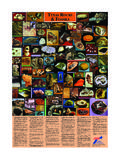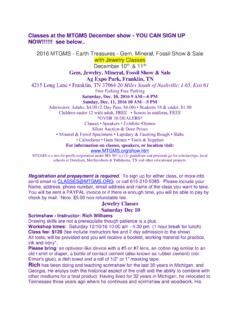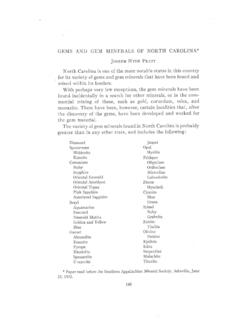Transcription of WISCONSIN’S WETLAND GEMS
1 wisconsin S WETLAND GEMSS outheast Coastal RegionSC-1 Chiwaukee PrairieSC-2 Des Plaines River Floodplain & MarshesSC-3 Germantown SwampSC-4 Renak-Polak WoodsSC-5 Root River Riverine ForestSC-6 Warnimont Bluff FensSoutheast RegionSE-1 Beulah BogSE-2 Cedarburg Bog SE-3 Cherokee MarshSE-4 Horicon MarshSE-5 Huiras Lake SE-6 Lulu LakeSE-7 Milwaukee River Floodplain ForestSE-8 Nichols CreekSE-9 Rush LakeSE-10 Scuppernong River AreaSE-11 Spruce Lake BogSE-12 Sugar River Floodplain ForestSE-13 Waubesa WetlandsSE-14 White River MarshCentral RegionC-1 Bass Lake Fen & Lunch Creek Sedge MeadowC-2 Bear Bluff BogC-3 Black RiverC-4 Blue SwampC-5 Comstock-Germania MarshC-6 Dewey MarshC-7 Jay Creek C-8 Page Creek MarshC-9 Quincy Bluff & Sohlberg LakeC-10 Suk-Cerney WetlandsC-11 Summerton BogWest RegionW-1 Big SwampW-2 Fort McCoyW-3 Kickapoo Valley ReserveW-4 Lower Chippewa River DeltaW-5 Lower St. Croix River CorridorW-6 Lower wisconsin River & Wyalusing State ParkW-7 Oak Ridge LakeW-8 Snow BottomsW-9 Trempealeau River Sedge Meadow W-10 Upper Mississippi & Trempealeau River National Wildlife RefugesW-11 Van Loon BottomsW-12 Whitman Bottoms Northeast RegionNE-1 Black Ash SwampNE-2 Brazeau SwampNE-3 Hortonville BogNE-4 Kangaroo LakeNE-5 Kohler Andrae DunesNE-6 Mink River EstuaryNE-7 Miscauno Cedar SwampNE-8 Moonlight Bay & Connected Wetlands NE-9 North BayNE-10 Peshtigo River DeltaNE-11 Point Beach & DunesNE-12 Rushes Lake NE-13 Shivering Sands & Connected WetlandsNE-14 West Shore Green Bay WetlandsNE-15 Wolf River BottomsNorth Central RegionNC-1 Atkins Lake & Hiles SwampNC-2 Bear Lake Sedge MeadowNC-3 Bogus SwampNC-4 Flambeau River State ForestNC-5 Grandma LakeNC-6 Hunting River AldersNC-7 Jump-Mondeaux River FloodplainNC-8 Kissick Alkaline Bog NC-9 Rice CreekNC-10 Savage-Robago LakesNC-11 Spider Lake NC-12 Toy Lake
2 SwampNC-13 Turtle-Flambeau- Manitowish PeatlandsNorthwest RegionNW-1 Belden Swamp NW-2 Black Lake BogNW-3 Blomberg LakeNW-4 Blueberry SwampNW-5 Brule Glacial SpillwayNW-6 Crex Meadows & Rice LakeNW-7 Empire SwampNW-8 Erickson Creek PeatlandsNW-9 Fish Lake MeadowNW-10 St. Croix & Namekagon River CorridorSuperior RegionSU-1 Bark Bay & Lost Creek BogSU-2 Bibon SwampSU-3 Big BaySU-4 Kakagon-Bad River SloughsSU-5 Nemadji Floodplain Forest SU-6 Outer Island Sandspit & LagoonSU-7 Pokegama-Carnegie WetlandsSU-8 Red Cliff Raspberry BaySU-9 Sand BaySU-10 St. Louis River MarshesSU-11 Stockton Island TomboloSU-12 Sultz SwampWorkhorse WetlandsWH-1 Turtle Valley Wildlife Area: Wildlife HabitatWH-2 Spoehr s Marsh: Fishery HabitatWH-3 MMSD Greenseams Program: Flood AttenuationWH-4 Halfway Creek Marsh: Water Quality ProtectionWH-5 Oconto Marsh: Shoreline ProtectionWH-6 Pheasant Branch: Groundwater ConnectionsWH-7 Mead Wildlife Area: Recreation & Education100 wisconsin WETLAND gems Mink River Estuary Clint FarlingerGreen Darner Dragonfly Ken TappGail Epping OverholtWHAT ARE WETLAND gems ?
3 WETLAND gems are high quality habitats that represent the WETLAND riches marshes, swamps, bogs, fens and more that historically made up nearly a quarter of wisconsin s landscape. Critically important to wisconsin s biodiversity, these natural treasures also provide our communities with valuable functions and services as well as recreational and educational opportunities. They are landscapes that both preserve the past and inspire for the Wetlands Association s list of 100 WETLAND gems includes 93 sites selected for their ecological value. These sites are distributed throughout the state and include examples of all of wisconsin s WETLAND community types. We have dubbed an additional seven Workhorse WETLAND gems , sites that illustrate how wetlands deliver priceless services such as flood attenuation, water quality protection, and fish and wildlife habitat. Look inside for more on the purpose of this project, how sites were selected, ideas for citizen and community involvement, a visitor s guide, and a list and map of the WETLAND gems sites.
4 Visit our website for more information on this project: MichiganLakeSuperiorNW-6NW-3NW-9NC-2NC-8 NC-11NC-4NC-7NC-13NC-12NC-9NC-10NC-5NC-1 NC-6NC-3NE-4NE-5NE-7NE-1NE-2 NE-6NE-8NE-12NE-13NE-9NE-10NE-14NE-15NE- 11NE-3SU-10SU-7SU-5SU-1SU-9SU-12SU-8SU-6 SU-11SU-3SU-4SU-2NW-4NW-2NW-1NW-7NW-8NW- 5NW-10SE-4SE-9SE-11SE-8SE-7SE-5SE-2SE-3S E-13SE-12SE-10SE-6SE-1SC-3SC-6SC-5SC-4SC -1SC-2W-8W-6W-3W-2W-11W-10W-9W-12W-1W-4W -5W-7C-4C-6C-3C-2C-7C-10C-1C-9C-11C-8C-5 SE-14020 Miles40NE-1 WETLAND Gem SiteSuperiorNortheastSoutheast CoastalSoutheastCentralWestNorthwestNort hcentralS TAT EWetland Gem RegionsWorkhorse WETLAND SiteWH-1WH-2WH-3WH-4WH-5WH-6WH-7WH-1 Funding for this project provided by The McKnight Foundation, which seeks to improve the quality of life for present and future generations through grantmaking, coalition-building and encouragement of strategic policy reform, and the wisconsin Coastal Management Program and National Oceanic & Atmospheric Administration.
5 Office of Ocean and Coastal Resource Management under the Coastal Zone Management Act, Grant # NA07 NOS4190064. WHY PUBLISH A WETLAND gems LIST?Historically, wetlands were not recognized and valued as natural treasures, but were instead generally considered wastelands and obstacles to progress. Since European settlement in the early 1800s, nearly half of wisconsin s original 10 million acres of wetlands have been drained or filled to make way for land uses like agriculture, forestry, and urban and suburban development. A large portion of the 5 million remaining acres have been altered and degraded, which only heightens the value of the high quality WETLAND treasures that remain. WETLAND gems collectively provide examples of our state s WETLAND misunderstanding and undervaluation of wetlands continues to be a key obstacle to WETLAND protection, conservation, and restoration efforts. Our purpose in promoting WETLAND gems is to increase appreciation for these precious resources.
6 Our vision is that the citizens of wisconsin will someday value all wetlands as natural treasures and that the historic and ongoing loss of WETLAND acres will be reversed. HOW WERE WETLAND GEM SITES SELECTED?The WETLAND gems list builds upon the results of extensive conservation planning efforts that identified critical habitats, threats, and conservation actions to protect the state s natural communities, species, and special places. These include The Nature Conservancy s Ecoregional Plans, the wisconsin Important Bird Areas Project, and the wisconsin Department of Natural Resources Land Legacy Report, Wildlife Action Plan, State Natural Areas Program, and Coastal Wetlands Assessment Report. After reviewing the above conservation plans, we worked with experts to select 93 sites that collectively represent the diversity of WETLAND community types present in each geographic region (see map, back cover).
7 Our goal was to include high quality representatives of each WETLAND community type found in each region. Wherever possible, we chose WETLAND gems that contained multiple WETLAND and upland community types representing fully functioning ecological WETLAND gems The seven Workhorse WETLAND gems illustrate the functional values described in the wisconsin Rapid WETLAND Assessment Methodology including wildlife habitat, fishery habitat, flood/stormwater attenuation, water quality protection, shoreline protection, groundwater, and recreation/education. Workhorse WETLAND sites were selected with input from our partners and natural resource experts. WETLAND TREASURES NOT ON THIS LISTThe WETLAND gems list is not exhaustive, but rather is a representative list of important, high quality wetlands in wisconsin . Not appearing on this list are millions of acres of valuable wetlands that play important roles within our landscapes and watersheds as critical wildlife habitat, sites of water purification, and sites of flood water storage.
8 All of the state s wetlands are valuable and merit protection. WETLAND VISITOR S GUIDE: VISIT A LOCAL WETLAND GEM Get your feet wet! wisconsin Wetlands Association encourages citizens and families to consider WETLAND destinations when planning recreational and educational outings. Our WETLAND gems list provides many wonderful options for outings, which include hiking, hunting, fishing, paddling, bird-watching, photography, and exploring. While most of these sites are on public land, some are privately owned; please pay close attention to the ownership and access information provided on our Gem site fact sheets when planning your sure to dress appropriately for weather, walking, and wading. Protect your skin from sun, scrapes, and insects with long-sleeved shirts, long pants, and a wide brimmed hat. Some sites offer boardwalks and other paths that are relatively dry, but generally recommended footwear includes rubber knee boots or old tennis shoes that you don t mind getting wet and muddy.
9 Be aware that Lyme disease is present in parts of the state. Prevent tick bites by wearing clothes that cover your skin and checking your skin and clothing for ticks when you get home. Bring water, field guides, and a sense of LightlyWetland Gem sites include sensitive species and habitats. Please follow the take only pictures, leave only footprints philosophy for your visit. Here are some specific guidelines to follow:Stay on trails (if available) and observe all regulations about trail usage, especially restrictions on ATVs. Where trails are not available, walk softly and leave the area as undisturbed as possible. Be aware of private property inholdings at some sites and do not not bring invaders with you! Prevent transporting invasive plant seeds by removing mud and soil from your shoes/boots and checking your clothing (including cuffs and pockets) to make sure there are no hitchhikers. Do not pick flowers or harvest any the temptation to take home souvenirs.
10 Leave items like stones , feathers, artifacts, wood, etc. so that others may enjoy them. State and federal laws prohibit removal of certain objects at some wildlife from a distance. Avoid nest areas and other areas where wildlife may be disrupted. Do not feed wildlife. Pack out what you pack in. Please pick up any trash you gems IN YOUR REGION: CITIZEN & COMMUNITY INVOLVEMENTW isconsin Wetlands Association encourages local conservation groups and other community organizations to celebrate and become stewards of their local and regional WETLAND gems . Below is a sampling of ideas that local citizens and organizations can use to contribute to the long-term protection of WETLAND treasures in their communities and regions:Celebrate & Raise Awareness of wisconsin s WETLAND gems News Flash: February 2 is World Wetlands Day and May is American Wetlands Month. Use these designations as opportunities to draw community and media attention to a regional Gem site.









